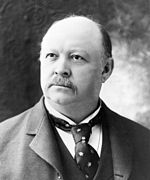This article needs additional citations for verification. (December 2009) |
| |||||||||||||||||||||||||||||||||||||||||||||||||||||||||||
All 332 seats in the United States House of Representatives[b] 167 seats needed for a majority | |||||||||||||||||||||||||||||||||||||||||||||||||||||||||||
|---|---|---|---|---|---|---|---|---|---|---|---|---|---|---|---|---|---|---|---|---|---|---|---|---|---|---|---|---|---|---|---|---|---|---|---|---|---|---|---|---|---|---|---|---|---|---|---|---|---|---|---|---|---|---|---|---|---|---|---|
| |||||||||||||||||||||||||||||||||||||||||||||||||||||||||||
 Map of U.S. House elections results from 1888 elections for 51st Congress on election day (a number of Southern seats were later successfully contested and the results overturned) | |||||||||||||||||||||||||||||||||||||||||||||||||||||||||||
| |||||||||||||||||||||||||||||||||||||||||||||||||||||||||||
The 1888 United States House of Representatives elections were held for the most part on November 6, 1888, with three states holding theirs early between June and September. They occurred at the same time as the election of President Benjamin Harrison. Elections were initially held for 325 seats of the United States House of Representatives, representing 38 states, to serve in the 51st United States Congress. Six new states would later join the union and increase the House to 332 seats. Special elections were also held throughout the year.
Harrison's Republican Party gained a majority in the House at the expense of the Democratic Party, even though incumbent President Grover Cleveland actually received more votes counted than Harrison. However, as in other elections in the period, widespread vote suppression and fraud was common on behalf of Democrats and against black Republicans in the South. The Republican House majority in uncontested elections unseated a number of initially reported as victorious Democratic candidates in favor of Republican candidates who contested their election loss. The issue of tariffs played a key role in this election. The Democrats, with the support of farmers and laborers, wanted to lower tariffs in order to promote free trade, while the Republicans, backed by industry and big business, believed that higher tariffs were necessary to protect American manufacturing. Especially in industrializing regions, voters chose the Republican view on tariffs, as they gave the party a slim majority in the House.
Hamilton D. Coleman’s win in the Second District would prove the last time until 1972 that a Republican won any House seat in Louisiana,[2] for the disenfrachisement of almost all blacks in the 1890s would leave that state completely devoid of Republican support until after the Dixiecrat bolt.[3]
Cite error: There are <ref group=lower-alpha> tags or {{efn}} templates on this page, but the references will not show without a {{reflist|group=lower-alpha}} template or {{notelist}} template (see the help page).
- ^ a b c Martis, pp. 142–143.
- ^ "Parish Follows Trend: Local Voters Support Nixon, Treen, Johnston". The St. Charles Herald. Hahnville, Louisiana. November 9, 1972. p. 1.
- ^ Phillips, Kevin P. The Emerging Republican Majority. pp. 208, 210. ISBN 9780691163246.


